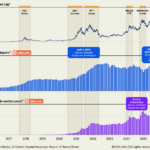Tuesday, December 23, 2008
Analyst Alchemy
(2 observations here. First, back in 2007 I recall reading that insurance companies had the same amount of 'toxic' mortgage assets on their books as the investment banks save that they were,in aggregate,of lower rating. The second is that the proposition that lower-rated mortgage backed securities are worth anything is in and of itself a fantasy.
On October 6, 2006 Citizen Grant produced a chart from Paul Singer, general partner of Elliott Associates, that was originally presented at a Grant's conference showing a home price depreciation of 7% or more would wipe out all MBS classes below AA- i.e., A and lower). We're not talking haircut, we're talking decapitation. The dead parrot sketch would most certainly apply.
These aren't money good, they are money gone.
Translation of article below : auditors are allowing insurance companies to state imaginary regulatory capital by turning nothing into something. -AM)
By LESLIE SCISM and DAVID REILLY
Wall Street Journal
December 23,2008
Accounting watchdogs are fast-tracking an effort to provide a small dose of "mark-to-market" relief for financial firms, as banks and life insurers continue grappling with deteriorating investment holdings.
The Financial Accounting Standards Board last week began steps to loosen a rule regarding when financial firms must book losses on a narrowly defined subset of lower-rated mortgage-backed securities, commercial-backed securities and certain other structured securities.
Late Friday, FASB asked for public comment on the proposal, a sign that it is under serious consideration.
For those financial firms that hold the relatively small group of securities at issue, managements and their auditors would have more leeway to put off a potential write-down that would clip net income. That could help bolster their regulatory capital.
Mark-to-market issues have taken center stage lately as life insurers designate swelling numbers of securities as "temporary impairments." They quarantine these "unrealized" losses in a special bucket within shareholder's equity called "other comprehensive income." Gains and losses in that bucket often aren't included in how regulators in the financial sector measure capital.
Eventually, though, if the losses don't reverse, a firm has to recognize them as "other than temporary." In that case, the loss runs through net income, a move that grabs investor attention and can affect measures of regulatory capital.
The numbers have gotten so huge -- $27 billion at giant insurer MetLife Inc. in late November -- that many investors are worried insurers are failing to recognize reality. And a battle could erupt at year end as auditors potentially demand write-downs of at least some of the securities.
The possible rule revision falls far short of what banking and insurance executives were seeking because they wanted relief that would give them greater leeway in valuing a wider range of securities. But it illustrates how aggressive they have become in trying to stave off paper losses. Analysts are still trying to figure out which companies might own the particular securities at issue.
FASB staff's proposed easing pertains to certain structured securities that were rated lower than double-A at the time of origination. Most pieces of a securitization are more highly rated when created, many at triple-A.
The rub is that there isn't a clear rule on when losses have to be recognized on any type of debt security. Many banks and insurers continue to maintain, even after some securities have shown market losses for more than a year, that they will eventually be money good. The insurers add that they match investments with policy obligations, and they have cash hoards to ensure they won't be forced sellers.
At MetLife, the nation's biggest life insurer by assets, unrealized losses more than doubled between Sept. 30 and late November, the company told analysts Dec. 8. The company says the "temporarily impaired" securities all are performing well and are overwhelmingly highly rated. It attributed many securities' declines to "supply/demand imbalances" as "deleveraging" continues in much of the financial world. The company expects $200 million to $300 million in realized losses for the fourth quarter.
The FASB staff said the goal is to make the rule more consistent with a broader impairment standard that permits "the use of reasonable management judgment" of the probability of collecting all amounts due. Its change isn't assured; some board members at last Monday's meeting expressed serious reservations about the move. Year-end conversations between auditors and insurance executives likely "will be substantial and somewhat heated," says Andrew Edelsberg, an analyst with ratings firm A.M. Best Co.
"At the end of the day, you have to have a methodology that makes sense and that will be ratified by your audit committee and your outside auditors," adds Rosemarie Mirabella, another analyst at Best.
Subscribe to:
Post Comments (Atom)



No comments:
Post a Comment